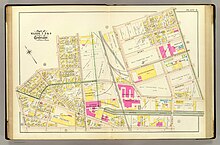Kendall Square
From 1880 to 1910, the eastern part of Cambridge hosted a variety of industries, including "printing and publishing, musical instruments (especially organs and pianos), furniture, clothing, carpenters work, soap and candles, and biscuit making."
[6] In 1961, after announcing[9] the American effort to land a man on the moon, President John F. Kennedy (a Massachusetts native) wanted to make Cambridge the site of NASA's newly expanded mission control center.
For the next twenty years, other large parcels of Kendall Square, which had also been cleared in anticipation of a much larger NASA complex, were an unoccupied post-industrial wasteland.
Opposition from Cambridge mayor Alfred Vellucci resulted in the city council passing a three-month moratorium and convening a citizen's committee to study the issue.
The resulting regulations passed in 1977 by the council provided certainty for research and development organizations, and led to the creation of the Kendall biotechnology cluster.
The first companies taking advantage of this were Harvard spin-off Genetics Institute (which ended up in Cambridge after opposition in Boston and Somerville, and which would eventually become part of Pfizer), and Biogen, which located in the city in 1982.
[citation needed] In 1997, the surviving industrial buildings between Third, Binney, Fifth, and Rogers Streets were declared the Blake and Knowles Steam Pump Company National Register District.
The Cambridge Center office development is closest to the junction of Main Street and Broadway and the MBTA subway station at the traditional core of Kendall Square.
Many other high technology firms are in two nearby multi-building office complex parks, both located about a 1⁄2 mile (0.80 km) from the traditional hub of Kendall Square.
[19] By 2014, a U.S. Department of Transportation building complex and its surrounding parking lots and open land at the western end of Kendall Square constituted one of the largest remaining areas not already subject to 21st century development.
[22] In January 2017, MIT signed an agreement with the federal government to purchase the 14-acre (5.7 ha) site of the John A. Volpe National Transportation Systems Center in Kendall Square, for $750 million.
[25] The MIT branch of the Harvard/MIT Cooperative Society ("The Coop") has for decades operated a modest department store and general bookstore at 325 Main Street, as Kendall Square's largest retailer.
Starting in October 2016, the Bookstore was temporarily relocated to Central Square, just north of the previous location of the MIT Museum, because of extensive construction on its former site.
A popular public artwork is the Kendall Band, an interactive sound sculpture by Paul Matisse, located in the Kendall/MIT subway station underground in the heart of the Square.
A bronze fountain sculpture, Galaxy: Earth Sphere by MIT professor Joe Davis, is installed at the junction of Main Street and Broadway in the Square.
[33] Small stainless-steel bicycle parking racks have been installed on sidewalks in the area, with various science-themed shapes, such as a sine wave or a caffeine molecule.



